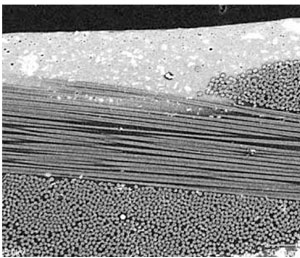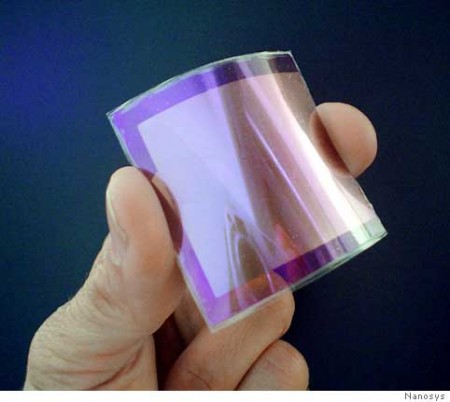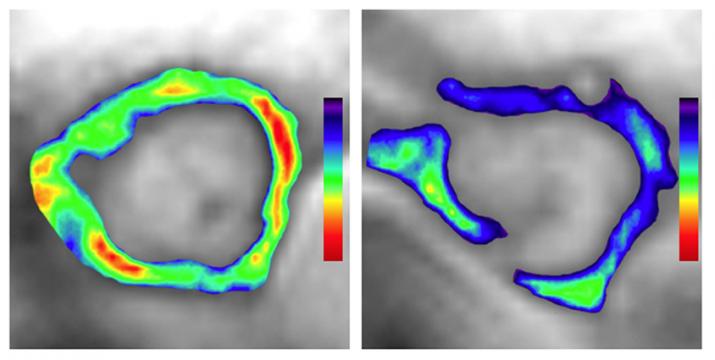After more than 20 years of basic nanoscience research and 10 years of focused R&D under the NNI, applications of nanotechnology are delivering in both expected and unexpected ways on nanotechnology’s promise to benefit society.
Nanotechnology is helping to considerably improve, even revolutionize, many technology and industry sectors: information technology, energy, environmental science, medicine, homeland security, food safety, and transportation, among many others. Described below is a sampling of the rapidly growing list of benefits and applications of nanotechnology.
Most benefits of nanotechnology depend on the fact that it is possible to tailor the essential structures of materials at the nanoscale to achieve specific properties, thus greatly extending the well-used toolkits of materials science. Using nanotechnology, materials can effectively be made to be stronger, lighter, more durable, more reactive, more sieve-like, or better electrical conductors, among many other traits. There already exist over 800 everyday commercial products that rely on nanoscale materials and processes:
- Nanoscale additives in polymer composite materials for baseball bats, tennis rackets, motorcycle helmets, automobile bumpers, luggage, and power tool housings can make them simultaneously lightweight, stiff, durable, and resilient.
- Nanoscale additives to or surface treatments of fabrics help them resist wrinkling, staining, and bacterial growth, and provide lightweight ballistic energy deflection in personal body armor.
- Nanoscale thin films on eyeglasses, computer and camera displays, windows, and other surfaces can make them water-repellent, antireflective, self-cleaning, resistant to ultraviolet or infrared light, antifog, antimicrobial, scratch-resistant, or electrically conductive.
- Nanoscale materials in cosmetic products provide greater clarity or coverage; cleansing; absorption; personalization; and antioxidant, anti-microbial, and other health properties in sunscreens, cleansers, complexion treatments, creams and lotions, shampoos, and specialized makeup.
- Nano-engineered materials in the food industry include nanocomposites in food containers to minimize carbon dioxide leakage out of carbonated beverages, or reduce oxygen inflow, moisture outflow, or the growth of bacteria in order to keep food fresher and safer, longer. Nanosensors built into plastic packaging can warn against spoiled food. Nanosensors are being developed to detect salmonella, pesticides, and other contaminates on food before packaging and distribution.

High-resolution image of a polymer-silicate nanocomposite. This material has improved thermal, mechanical, and barrier properties and can be used in food and beverage containers, fuel storage tanks for aircraft and automobiles, and in aerospace components. (Image courtesy of NASA.) - Nano-engineered materials in automotive products include high-power rechargeable battery systems; thermoelectric materials for temperature control; lower-rolling-resistance tires; high-efficiency/low-cost sensors and electronics; thin-film smart solar panels; and fuel additives and improved catalytic converters for cleaner exhaust and extended range.
- Nano-engineered materials make superior household products such as degreasers and stain removers; environmental sensors, alert systems, air purifiers and filters; antibacterial cleansers; and specialized paints and sealing products.
- Nanostructured ceramic coatings exhibit much greater toughness than conventional wear-resistant coatings for machine parts. In 2000, the U.S. Navy qualified such a coating for use on gears of air-conditioning units for its ships, saving $20 million in maintenance costs over 10 years. Such coatings can extend the lifetimes of moving parts in everything from power tools to industrial machinery.
- Nanoparticles are used increasingly in catalysis to boost chemical reactions. This reduces the quantity of catalytic materials necessary to produce desired results, saving money and reducing pollutants. Two big applications are in petroleum refining and in automotive catalytic converters.
Nanotechnology is already in use in many computing, communications, and other electronics applications to provide faster, smaller, and more portable systems that can manage and store larger and larger amounts of information. These continuously evolving applications include:
- Nanoscale transistors that are faster, more powerful, and increasingly energy-efficient; soon your computer’s entire memory may be stored on a single tiny chip.
- Magnetic random access memory (MRAM) enabled by nanometer‐scale magnetic tunnel junctions that can quickly and effectively save even encrypted data during a system shutdown or crash, enable resume‐play features, and gather vehicle accident data.
- Displays for many new TVs, laptop computers, cell phones, digital cameras, and other devices incorporate nanostructured polymer films known as organic light-emitting diodes, or OLEDs. OLED screens offer brighter images in a flat format, as well as wider viewing angles, lighter weight, better picture density, lower power consumption, and longer lifetimes.
- Other computing and electronic products include Flash memory chips for iPod nanos; ultraresponsive hearing aids; antimicrobial/antibacterial coatings on mouse/keyboard/cell phone casings; conductive inks for printed electronics for RFID/smart cards/smart packaging; more life-like video games; and flexible displays for e-book readers.
The difficulty of meeting the world’s energy demand is compounded by the growing need to protect our environment. Many scientists are looking into ways to develop clean, affordable, and renewable energy sources, along with means to reduce energy consumption and lessen toxicity burdens on the environment.
- Prototype solar panels incorporating nanotechnology are more efficient than standard designs in converting sunlight to electricity, promising inexpensive solar power in the future. Nanostructured solar cells already are cheaper to manufacture and easier to install, since they can use print-like manufacturing processes and can be made in flexible rolls rather than discrete panels. Newer research suggests that future solar converters might even be “paintable.”
 |
| New solar panel films incorporate nanoparticles to create lightwieght, flexible solar cells. (Image courtesy of Nanosys |
- Nanotechnology is improving the efficiency of fuel production from normal and low-grade raw petroleum materials through better catalysis, as well as fuel consumption efficiency in vehicles and power plants through higher-efficiency combustion and decreased friction.
- Nano-bioengineering of enzymes is aiming to enable conversion of cellulose into ethanol for fuel, from wood chips, corn stalks (not just the kernels, as today), unfertilized perennial grasses, etc.
- Nanotechnology is already being used in numerous new kinds of batteries that are less flammable, quicker-charging, more efficient, lighter weight, and that have a higher power density and hold electrical charge longer. One new lithium-ion battery type uses a common, nontoxic virus in an environmentally benign production process.
- Nanostructured materials are being pursued to greatly improve hydrogen membrane and storage materials and the catalysts needed to realize fuel cells for alternative transportation technologies at reduced cost. Researchers are also working to develop a safe, lightweight hydrogen fuel tank.
- Various nanoscience-based options are being pursued to convert waste heat in computers, automobiles, homes, power plants, etc., to usable electrical power.
- An epoxy containing carbon nanotubes is being used to make windmill blades that are longer, stronger, and lighter-weight than other blades to increase the amount of electricity that windmills can generate.
- Researchers are developing wires containing carbon nanotubes to have much lower resistance than the high-tension wires currently used in the electric grid and thus reduce transmission power loss.
- To power mobile electronic devices, researchers are developing thin-film solar electric panels that can be fitted onto computer cases and flexible piezoelectric nanowires woven into clothing to generate usable energy on-the-go from light, friction, and/or body heat.
- Energy efficiency products are increasing in number and kinds of application. In addition to those noted above, they include more efficient lighting systems for vastly reduced energy consumption for illumination; lighter and stronger vehicle chassis materials for the transportation sector; lower energy consumption in advanced electronics; low-friction nano-engineered lubricants for all kinds of higher-efficiency machine gears, pumps, and fans; light-responsive smart coatings for glass to complement alternative heating/cooling schemes; and high-light-intensity, fast-recharging lanterns for emergency crews.
Besides lighter cars and machinery that requires less fuel, and alternative fuel and energy sources, there are many eco-friendly applications for nanotechnology, such as materials that provide clean water from polluted water sources in both large-scale and portable applications, and ones that detect and clean up environmental contaminants.
- Nanotechnology could help meet the need for affordable, clean drinking water through rapid, low-cost detection of impurities in and filtration and purification of water. For example, researchers have discovered unexpected magnetic interactions between ultrasmall specks of rust, which can help remove arsenic or carbon tetrachloride from water (see image); they are developing nanostructured filters that can remove virus cells from water; and they are investigating a deionization method using nano-sized fiber electrodes to reduce the cost and energy requirements of removing salts from water.
 |
Nanorust cleans arsenic from drinking water.
(Image courtesy of Rice University) |
- Nanoparticles will someday be used to clean industrial water pollutants in ground water through chemical reactions that render them harmless, at much lower cost than methods that require pumping the water out of the ground for treatment.
- Researchers have developed a nanofabric "paper towel," woven from tiny wires of potassium manganese oxide, that can absorb 20 times its weight in oil for cleanup applications.
- Many airplane cabin and other types of air filters are nanotechnology-based filters that allow “mechanical filtration,” in which the fiber material creates nanoscale pores that trap particles larger than the size of the pores. They also may contain charcoal layers that remove odors. Almost 80% of the cars sold in the U.S. include built-in nanotechnology-based filters.
- New nanotechnology-enabled sensors and solutions may one day be able to detect, identify, and filter out, and/or neutralize harmful chemical or biological agents in the air and soil with much higher sensitivity than is possible today. Researchers around the world are investigating carbon nanotube “scrubbers,” and membranes to separate carbon dioxide from power plant exhaust. And researchers are investigating particles such as self-assembled monolayers on mesoporous supports (SAMMS™), dendrimers, carbon nanotubes, and metalloporphyrinogens to determine how to apply their unique chemical and physical properties for various kinds of toxic site remediation.
Nanotechnology has the real potential to revolutionize a wide array of medical and biotechnology tools and procedures so that they are more personalized, portable, cheaper, safer, and easier to administer. Below are some examples of important advances in these areas.
- Quantum dots are semiconducting nanocrystals that can enhance biological imaging for medical diagnostics. When illuminated with ultraviolet light, they emit a wide spectrum of bright colors that can be used to locate and identify specific kinds of cells and biological activities. These crystals offer optical detection up to 1,000 times better than conventional dyes used in many biological tests, such as MRIs, and render significantly more information.
- Nanotechnology has been used in the early diagnosis of atherosclerosis, or the buildup of plaque in arteries. Researchers have developed an imaging technology to measure the amount of an antibody-nanoparticle complex that accumulates specifically in plaque. Clinical scientists are able to monitor the development of plaque as well as its disappearance following treatment (see image).
 |
Before (left) and after (right) picture of atherosclerotic placque in a mouse artery. Placque accumulation is shown in this image by the increasing intensity of color, from blue to yellow and red. (Image courtesy of M. Nahrendorf, MGH Center for Systems Biology, Harvard Medical School)
|
- Gold nanoparticles can be used to detect early-stage Alzheimer’s disease.
- Molecular imaging for the early detection where sensitive biosensors constructed of nanoscale components (e.g., nanocantilevers, nanowires, and nanochannels) can recognize genetic and molecular events and have reporting capabilities, thereby offering the potential to detect rare molecular signals associated with malignancy.
- Multifunctional therapeutics where a nanoparticle serves as a platform to facilitate its specific targeting to cancer cells and delivery of a potent treatment, minimizing the risk to normal tissues.
- Research enablers such as microfluidic chip-based nanolabs capable of monitoring and manipulating individual cells and nanoscale probes to track the movements of cells and individual molecules as they move about in their environments.
- Research is underway to use nanotechnology to spur the growth of nerve cells, e.g., in damaged spinal cord or brain cells. In one method, a nanostuctured gel fills the space between existing cells and encourages new cells to grow. There is early work on this in the optical nerves of hamsters. Another method is exploring use of nanofibers to regenerate damaged spinal nerves in mice.
In addition to contributing to building and maintaining lighter, smarter, more efficient, and “greener” vehicles, aircraft, and ships, nanotechnology offers various means to improve the transportation infrastructure:
- Nano-engineering of steel, concrete, asphalt, and other cementitious materials, and their recycled forms, offers great promise in terms of improving the performance, resiliency, and longevity of highway and transportation infrastructure components while reducing their cost. New systems may incorporate innovative capabilities into traditional infrastructure materials, such as the ability to generate or transmit energy.
- Nanoscale sensors and devices may provide cost-effective continuous structural monitoring of the condition and performance of bridges, tunnels, rails, parking structures, and pavements over time. Nanoscale sensors and devices may also support an enhanced transportation infrastructure that can communicate with vehicle-based systems to help drivers maintain lane position, avoid collisions, adjust travel routes to circumnavigate congestion, and other such activities.
 |
| Future sensor systems will be able to use multiple physical phenomena to sense many analytes simultaneously for a variety of applications, some of which are noted above. Illustrated here are (left to right) an optical tranducer, which measures light; an electro/chemical tranducer, which measures electrical properties; a magnetic tranducer, which measures changes to the local magnetic field; and a mechanical transducer, which detects changes in motion. (Image by N.R. Fuller, Sayo-Art.) |
Besides moving forward to capture these and many other benefits of nanotechnologies, the NNI is also committed to addressing the potential environmental, health, and safety impacts and various societal, legal, or ethical implications of nanotechnology to avoid or minimize any undesirable or unintended effects of nanotechnology.
SOURCE:http://www.nano.gov/you/nanotechnology-benefits
No comments:
Post a Comment